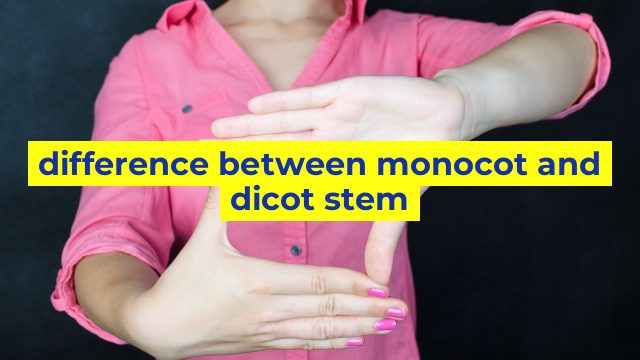The Difference between Monocot and Dicot Stems
When it comes to plant structure, stems are one of the most important parts of the plant anatomy. They are responsible for supporting the plant’s leaves, flowers, and fruits. Depending on the plant species, stems can be either monocot or dicot. In this article, we will explore the key differences between monocot and dicot stems.
Monocot Stems
Monocot stems are characterized by having a scattered arrangement of vascular bundles. These vascular bundles are arranged in a circular pattern around the stem’s circumference. Monocots have one cotyledon, which is the embryonic leaf that emerges from the seed upon germination. This cotyledon remains intact throughout the life cycle of the plant.
Another distinguishing feature of monocot stems is that they lack secondary growth. This means that they do not increase in thickness over time. Monocot stems are mostly herbaceous, although some species can have woody stems.
Some examples of monocots include grasses, lilies, orchids, and palms.
Dicot Stems
Dicot stems, on the other hand, have a different arrangement of vascular bundles. They have a cylindrical arrangement of vascular bundles, which are arranged in a ring pattern around the stem’s circumference. Dicots have two cotyledons, which emerge from the seed upon germination. These cotyledons eventually wither away.
One of the main features of dicot stems is that they undergo secondary growth. This means that they increase in thickness over time due to the activity of the cambium. The cambium is a layer of cells located between the xylem and the phloem. It is responsible for producing new cells that eventually differentiate into either xylem or phloem cells.
Most dicots have woody stems, meaning that they are able to withstand the weight of leaves, flowers, and fruits. Examples of dicots include trees, shrubs, and flowering plants such as roses, daisies, and tomatoes.
Conclusion
In summary, the key differences between monocot and dicot stems lie in their vascular bundle arrangement, number of cotyledons, and ability to undergo secondary growth. Understanding these differences is essential for plant taxonomy and for the proper care of plants, as different species may require specific watering, fertilizing, and pruning techniques.
Table difference between monocot and dicot stem
| Monocot Stem | Dicot Stem |
|---|---|
| Contains scattered vascular bundles without any distinct organization | Contains organized rings of vascular bundles arranged in a circular pattern |
| Has a single layered epidermis | Has a multi-layered epidermis with cuticle and stomata |
| Cortex is not well differentiated | Cortex is well differentiated and contains collenchyma and sclerenchyma cells |
| No secondary growth occurs | Secondary growth occurs due to the presence of cambium |
| No pith is present in the stem | Pith is present in the center of the stem, made up of parenchyma cells |


